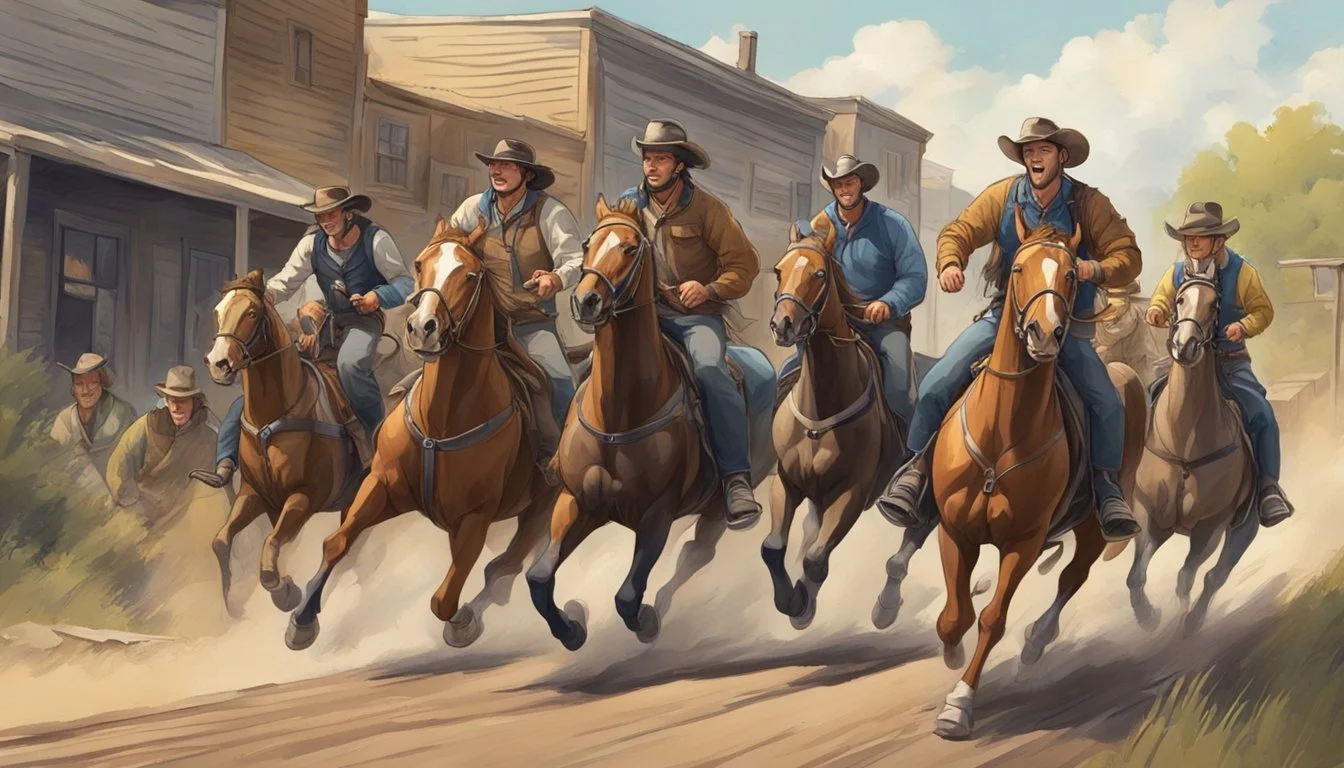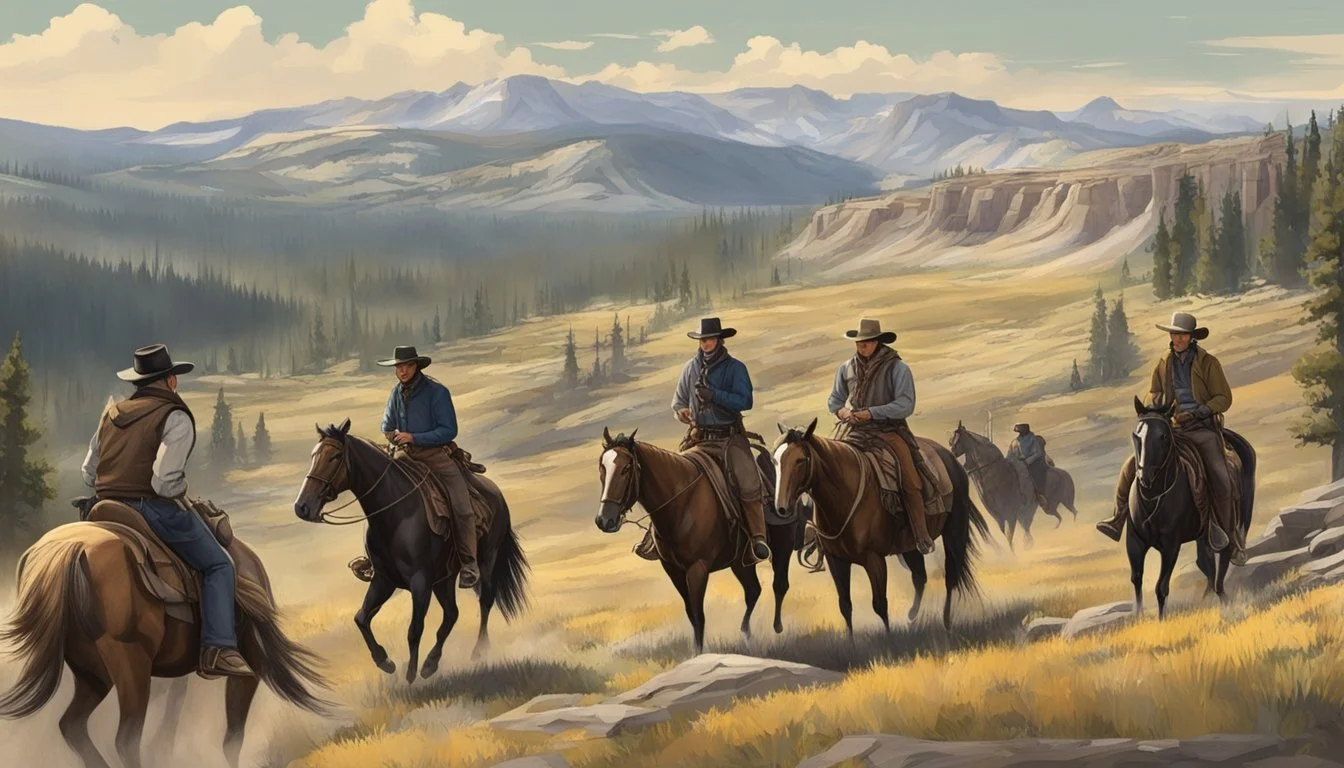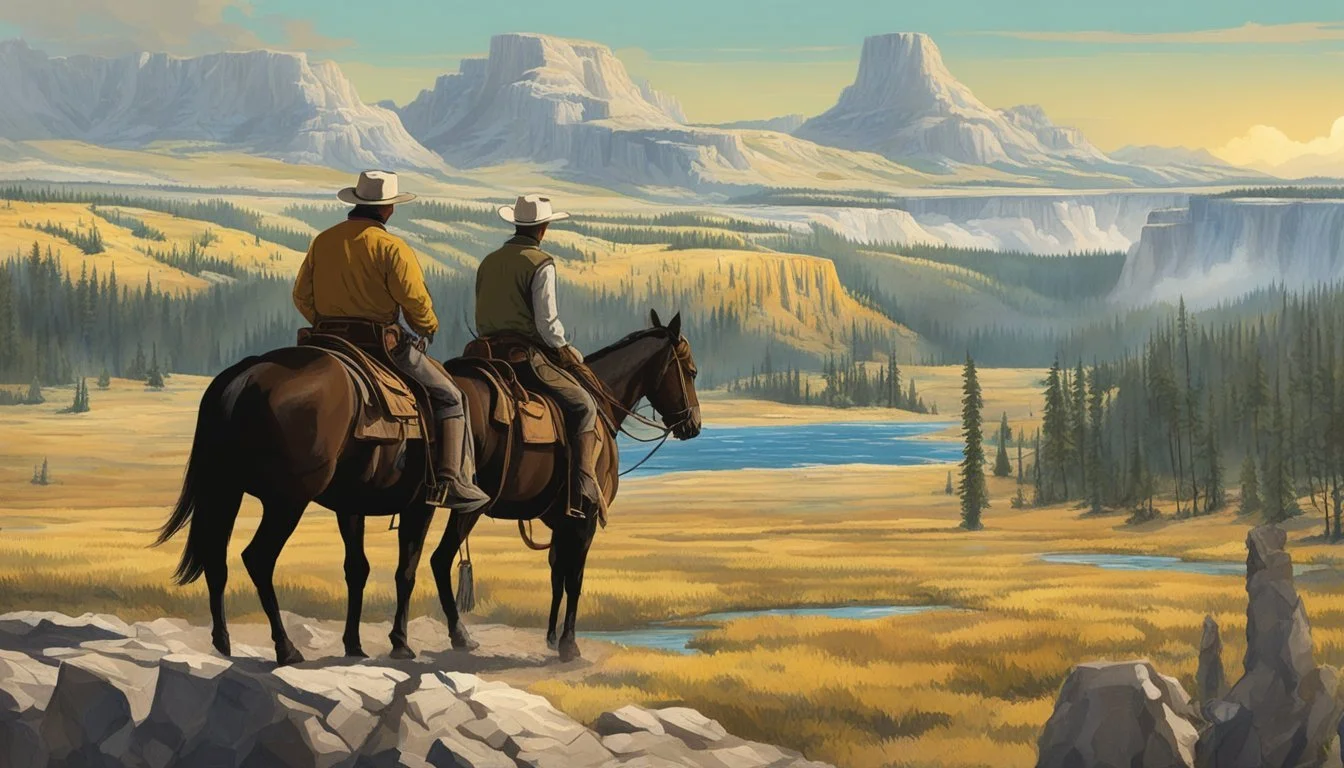Yellowstone Unveils Shocking Secrets of Small-Town Power Struggles in Rural America
Yellowstone, the gripping TV series created by Taylor Sheridan, offers a nuanced portrayal of small-town politics and power dynamics in rural America. Set against the backdrop of Montana's rugged landscape, the show explores the complex interplay between land ownership, family legacy, and political maneuvering.
At the center of this rural drama stands the Dutton family, led by patriarch John Dutton, portrayed by Kevin Costner. The series skillfully depicts the tensions between traditional ranching culture and modern economic pressures, showcasing the challenges faced by rural communities in an ever-changing world. Through its narrative, Yellowstone sheds light on contentious issues such as land preservation, environmental concerns, and the impact of development on rural areas.
The show's portrayal of power dynamics extends beyond the Dutton ranch, delving into the broader political landscape of rural America. It explores the intricate relationships between local politicians, business interests, and community members, highlighting the often-blurred lines between personal and public interests in small-town governance.
Historical Context of 'Yellowstone'
The TV series 'Yellowstone' draws inspiration from the rich tapestry of the American West's history, ranching culture, and generational legacies. It reflects the ongoing struggles and transformations in rural America.
Backdrop of the American West
Westward Expansion shaped the American frontier, setting the stage for 'Yellowstone'. Settlers pushed into territories like Montana, displacing Native American tribes. The establishment of Yellowstone National Park in 1872 marked a shift in land use priorities.
The show's setting in Paradise Valley echoes this history. It portrays the tension between preservation and development that has defined the region for over a century.
Cultural Significance of Ranching
Ranching became a cornerstone of Western identity following the Civil War. Large cattle operations, like the fictional Dutton Ranch, dominated the landscape.
These ranches shaped local economies and power structures. 'Yellowstone' depicts how this tradition continues to influence modern rural politics and culture.
The series showcases iconic locations like the Chief Joseph Ranch, connecting viewers to authentic Western heritage.
The Dutton Family Legacy
'Yellowstone' places the Dutton family's multi-generational ranch at the center of its narrative. This fictional dynasty mirrors real historical cattle empires that emerged in the late 19th century.
The show's prequels, set in 1883 and 1923, explore the family's origins during pivotal periods of Western settlement. These storylines highlight the challenges faced by early ranchers and the foundations of their enduring influence.
The Duttons' interactions with the Montana State Capitol reflect the historical intertwining of ranching interests and state politics. This dynamic continues to shape rural American governance today.
Political Landscape in 'Yellowstone'
'Yellowstone' portrays a complex political ecosystem in rural Montana. Power dynamics between key figures, local communities, and outside interests shape the narrative and reflect real-world tensions.
Leadership and Governance
John Dutton stands as the central political figure in 'Yellowstone'. As a rancher and Livestock Commissioner, he wields significant influence over local affairs. His leadership style blends traditional values with pragmatic decision-making.
Dutton's political power extends beyond his official role. He leverages personal connections and economic clout to protect his interests. This often puts him at odds with state officials and corporate entities.
The show depicts rural politics as deeply personal. Family ties and longstanding feuds play crucial roles in shaping alliances and conflicts. Local elections and policy decisions frequently hinge on these relationships.
Interactions with Indigenous Communities
Thomas Rainwater emerges as a key player representing Native American interests. As chairman of the Broken Rock Indian Reservation, he navigates complex political waters.
Tribal sovereignty is a recurring theme. The show explores the legal and cultural challenges faced by Native communities in asserting their rights. Conflicts over land use and resource management highlight historical injustices.
'Yellowstone' portrays the delicate balance between cooperation and competition. Rainwater and Dutton often find themselves as reluctant allies against external threats, despite their conflicting goals.
Corporate Versus Community Interests
Corporate interests serve as a major political force in 'Yellowstone'. Large companies seek to exploit the region's natural resources, often clashing with local ranchers and indigenous communities.
The series showcases the power imbalance between well-funded corporations and rural residents. Political lobbying, economic pressure, and legal maneuvers are depicted as tools used by businesses to advance their agendas.
Community resistance takes various forms. From grassroots organizing to strategic alliances, local characters fight to preserve their way of life. The show highlights the challenges of maintaining rural traditions in the face of modernization and development pressures.
Family Dynamics and Power
The Dutton family's complex relationships and power struggles drive much of Yellowstone's dramatic tension. Their dynastic control of vast ranch lands intertwines with personal conflicts and succession planning.
The Complexities of the Dutton Family
John Dutton leads his children with an iron will, shaping their roles within the family empire. Beth's fierce loyalty clashes with Jamie's political ambitions. Kayce struggles to balance ranch responsibilities with his own family.
Each Dutton child vies for John's approval in their own way. Beth's ruthless business tactics aim to protect the ranch. Jamie's legal and political maneuvers often put him at odds with family interests. Kayce's military background informs his approach to ranch operations.
The family's wealth and influence create a stark contrast with the surrounding community. This power imbalance fuels both loyalty and resentment among ranch employees and locals.
Alliances and Rivalries
Shifting alliances mark the Dutton family dynamics. Beth and Rip's relationship strengthens her position. Jamie's adoption revelation strains his place in the family. Kayce's marriage to a Native American woman adds complexity to tribal relations.
External threats force temporary truces between feuding family members. Business rivals, politicians, and developers challenge the Duttons' control, requiring a united front. These pressures test loyalties and reveal character motivations.
Family rivalries often play out in boardrooms and backroom deals. Beth's financial acumen clashes with Jamie's legal strategies. John's traditional ranching methods sometimes conflict with modern business realities.
Succession and Legacy
John Dutton's determination to preserve his legacy drives many plot points. His children compete to prove their worth as potential heirs. The ranch represents more than land—it embodies generations of family history and power.
The question of succession creates tension and uncertainty. Each Dutton child brings different strengths and weaknesses to leadership consideration. John's reluctance to relinquish control complicates transition planning.
External pressures from developers and changing economic realities threaten the ranch's future viability. This forces the family to consider new strategies for maintaining their dynasty and influence in a changing Montana landscape.
Socioeconomic Issues Portrayed
Yellowstone showcases complex socioeconomic challenges facing rural America. The series highlights disparities in wealth, environmental pressures on ranchers, and tensions between urban and rural communities.
Wealth, Land, and Ownership
Land ownership emerges as a central theme in Yellowstone's portrayal of rural socioeconomics. The Dutton family's vast ranch represents generational wealth and power. Their struggle to maintain control reflects real-world concerns about land consolidation and changing ownership patterns in rural areas.
Wealthy outsiders and developers vie for prime real estate, driving up property values. This creates pressure on long-time residents and ranchers to sell their land. The show depicts how this shift impacts local economies and community dynamics.
Yellowstone also touches on issues of gentrification in rural settings. As affluent urbanites move in, housing costs rise and traditional ways of life are threatened.
Environmental Challenges Facing Ranchers
Ranchers in Yellowstone grapple with environmental regulations and conservation efforts. The show portrays conflicts between ranching operations and wildlife protection, mirroring real-world debates over land use and endangered species.
Climate change impacts like drought and wildfires pose threats to ranching livelihoods. These environmental pressures add financial strain to already tight profit margins in the cattle industry.
Water rights emerge as a crucial issue. The series depicts battles over access to water resources, reflecting actual disputes in arid Western states. These conflicts pit ranchers against each other and against urban water needs.
Urban-Rural Disparities
Yellowstone highlights the growing divide between urban and rural America. The show portrays rural areas struggling with limited economic opportunities and declining populations. This contrasts sharply with the wealth and development pressures from urban areas.
Access to healthcare, education, and other services emerges as a key disparity. The series touches on the challenges of attracting and retaining professionals in rural communities.
Political power imbalances between urban and rural areas are also explored. The show depicts how rural residents often feel overlooked by state and federal policies shaped by urban interests.
Cultural and Identity Themes
Yellowstone explores the complex cultural landscape of rural America, weaving together themes of tradition, modernity, and diverse identities. The show grapples with the evolving nature of Western culture and the challenges faced by communities in transition.
Deconstructing the Myth of the West
Yellowstone challenges romanticized notions of the American West. The series portrays a nuanced reality where cowboy culture clashes with modern pressures. Characters struggle to maintain their way of life in the face of economic and social changes.
The show examines the iconic figure of the cowboy, revealing both strength and vulnerability. It depicts the harsh realities of ranch life, moving beyond stereotypes to show the daily struggles of rural communities.
Yellowstone also addresses the dark chapters of Western history, including conflicts with Native Americans and environmental exploitation. This honest portrayal forces viewers to confront the complexities of American expansion and its lasting impacts.
Ranching Traditions and Modernity
The Dutton family embodies the tension between preserving ranching heritage and adapting to the modern world. Their vast ranch serves as a symbol of traditional values and a bygone era.
Yellowstone showcases authentic ranching practices, from cattle drives to branding. These scenes celebrate the skills and knowledge passed down through generations of ranchers.
At the same time, the show highlights the challenges of maintaining these traditions in the face of technological advancements and changing economic landscapes. Characters grapple with modernizing their operations while preserving their cultural identity.
The series explores how ranching families navigate succession planning and the pressures of keeping their land intact for future generations. This struggle reflects broader issues facing rural communities across America.
The Melting Pot of Rural Communities
Yellowstone depicts the diverse tapestry of rural America, challenging stereotypes of homogeneous small towns. The show portrays a mix of long-time residents, newcomers, and Native American communities.
The series explores the tensions and alliances that form between different groups. It shows how shared challenges can bring people together across cultural divides.
Native American characters play a significant role, offering perspectives on land rights and cultural preservation. The show addresses the complex relationship between tribal communities and their non-Native neighbors.
Yellowstone also touches on the influx of wealthy outsiders to rural areas, examining how this demographic shift impacts local culture and economies. The series raises questions about authenticity and belonging in changing rural landscapes.
Land and Conservation in 'Yellowstone'
The hit TV series "Yellowstone" explores complex land use issues and conservation debates central to rural America. Conflicts over property rights, preservation efforts, and economic pressures drive key storylines.
Land Conflicts and Conservation
The Dutton family's struggle to maintain their vast ranch highlights tensions between development and conservation. As outside interests seek to acquire or exploit the land, the Duttons fight to preserve their way of life. This mirrors real challenges faced by ranchers and landowners near protected areas like Yellowstone National Park.
Conservation easements emerge as a potential tool to safeguard the ranch. These legal agreements limit land use to protect natural resources while allowing continued private ownership. The show examines the pros and cons of such arrangements.
Water rights also play a crucial role. Access to rivers and streams for irrigation becomes a point of contention, reflecting actual disputes in the American West.
Preservation of the Yesteryears
"Yellowstone" portrays the Dutton Ranch as a living link to America's frontier past. The family's efforts to maintain traditional ranching practices clash with modern economic realities. This struggle resonates with viewers nostalgic for a romanticized vision of the Old West.
The show explores the cultural value of preserving historic working landscapes. It raises questions about the costs and benefits of resisting change in rural communities. The Duttons' commitment to their legacy often puts them at odds with forces of progress and development.
Legal Battles over Property
Property rights take center stage in many of the show's conflicts. The Duttons face legal challenges to their land claims, echoing real-world disputes over boundaries, easements, and mineral rights.
Eminent domain emerges as a threat, with government and corporate interests seeking to take portions of the ranch for various projects. These storylines reflect actual tensions between private property owners and public land use initiatives.
The series also touches on issues of tribal land rights, exploring the complex history of land ownership in the region. This adds depth to discussions of who truly has claim to the contested landscapes.
Influence of 'Yellowstone' on Popular Culture
Yellowstone has made a significant impact on popular culture, reshaping the Neo-Western genre and sparking discussions about rural America. The show's realistic portrayal and compelling narrative have captivated audiences nationwide.
Neo-Western Genre and 'Yellowstone'
Yellowstone has revitalized the Western genre for modern audiences. Its blend of traditional Western elements with contemporary themes has created a new subgenre: the Neo-Western. The show's success has paved the way for similar productions, influencing the television landscape.
Yellowstone's cinematic style, featuring sweeping shots of Montana's scenic beauty, has set a new standard for visual storytelling in television. This approach has inspired other productions to focus on landscape as a character in itself.
The series has also popularized Western fashion, leading to increased demand for cowboy hats, boots, and ranch-style clothing.
Realism and Representation in the Series
Yellowstone's commitment to authenticity has resonated with viewers, particularly those from rural areas. The show depicts the complexities of modern ranching, land disputes, and small-town politics with nuance and depth.
This portrayal has sparked conversations about rural issues often overlooked in mainstream media. Yellowstone has brought attention to challenges faced by ranching communities, including land conservation, economic pressures, and conflicts with government entities.
The series has also highlighted Native American perspectives, featuring indigenous characters and storylines that explore the complex relationships between tribal nations and other local stakeholders.
Impact of the Dutton Narrative
The Dutton family's saga has become a cultural touchstone, inspiring discussions about family dynamics, power, and legacy. The show's exploration of generational wealth and its preservation has struck a chord with viewers across diverse backgrounds.
Yellowstone's portrayal of strong, complex characters has influenced casting trends in television, promoting more nuanced representations of rural and Western archetypes.
The series has also boosted tourism in Montana, with fans eager to experience the landscapes featured in the show. This influx has had significant economic impacts on local communities, while also raising concerns about potential over-tourism.
Show Production Details
Yellowstone's production combines stunning locations with state-of-the-art filmmaking techniques to create an immersive viewing experience. The show's success stems from its authentic portrayal of rural America and the talent behind the scenes.
Filming Locations and Hollywood Magic
Yellowstone utilizes diverse locations to capture the beauty of the American West. The series primarily films in Utah and Montana. Utah Film Studio in Park City serves as the production's home base, housing interior sets and providing post-production facilities.
Exterior shots showcase picturesque landscapes in Montana, including the Bitterroot Valley near Hamilton and Darby. Spanish Fork, Utah, doubles as the fictional town of Paradise Valley. The show's cinematography emphasizes wide-angle shots to highlight the region's vast expanses.
Special effects enhance the authenticity of ranch life scenes. CGI is used sparingly, mainly for dangerous stunts or to amplify natural elements like wildfires or stampedes.
The Making Of a TV Phenomenon
Yellowstone's creator, Taylor Sheridan, drew from his ranching background to ensure authenticity. The production team includes experienced wranglers and cowboys who advise on horseback riding scenes and cattle management.
Costume design plays a crucial role in character development. Each character's wardrobe reflects their personality and social status within the show's hierarchy.
The series employs a mix of practical effects and digital enhancements. Real horses and cattle are used in most scenes, with safety measures in place to protect both animals and actors.
Reception and Critique
Yellowstone has garnered a massive following since its 2018 debut on Paramount Network. Critics praise the show's cinematography and performances, particularly Kevin Costner's portrayal of John Dutton.
Some reviewers note the series' nuanced exploration of modern rural issues. Others critique its depiction of Native American characters and occasional reliance on melodrama.
The show's popularity has led to a surge in tourism for its filming locations. Local economies in Utah and Montana have benefited from increased visitor interest in experiencing the "Yellowstone lifestyle."







